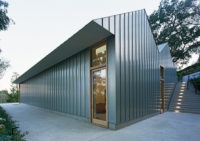Melbourne, Australia
The Zinc House is an adaptive re-use of a building that dates back to the 19th century. Remnants of the original bakery remained when the building was redeveloped in the 1950s as a fire station, before it was later converted for residential use. It has now been remodeled as a home and gallery for a Melbourne art dealer and publisher.
Design concept and solution: The 9,063-square-foot house is simultaneously a private art gallery and residence whose spaces—a vast open living and gallery area, private rooms, corridors, and service zones—are defined by zinc detailing. The use of zinc gives warmth to the otherwise harsh concrete used throughout the project, as exterior surfaces are finished in a natural mid-gray cement, blending the built form into the light and shade of the street’s fabric.
On entering, a section of a thick zinc-clad blade wall pivots to allow access through the gallery to the living areas of the house, which form a single continuous volume. Art and family living merge and flow, with the private elements of domestic life concealed by the wall and its pivoting door panels.
Reinstating the original rectangular building form was a matter of demolishing a rear addition, thus allowing a more generous north-facing garden. A single horizontal opening onto an open roof terrace gives depth to the original solidity of form. A horizontal zinc blade (sectionally a wedged parallelogram) extends the width of the opening, pivoting for privacy and eastern morning sun protection, or views to the park opposite. In its open position the blade conveys a traditional terrace veranda.
At street level, an existing tilt-up glazed door opening is enlarged to allow natural light into the interior. The new opening carries a view from the interior to the street, while an inclined zinc screen retains internal privacy. Beneath the screen and behind the glazing, garaged cars remain visible elements of the streetscape.
Wedge-shaped dividers housing audio-visual equipment and storage rotate to “de-scale” the single volume (dividers set parallel to the axis) to a sequence of spaces (dividers set at right angles to the axis).
The house, which won an Australian National Architecture Award for residential architecture in 2011, sits comfortably in its surroundings, expressing a coolly ordered calm.
People
Architect:
Consultant(s)
Services:
Landscape:
Builder:
Photographer: |
Products |






















